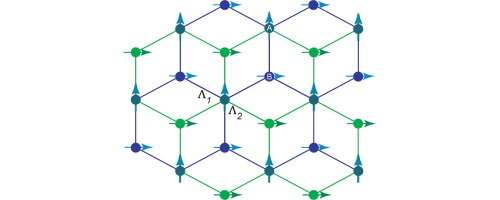Bilayer CrBr3 lattice forms an AB-stacking. CrBr3 favors an easy-plane intralayer anisotropy, and a uniaxial interlayer anisotropy, which is effective only on ''A” sites. Credit: Science Bulletin (2022). DOI: 10.1016/j.scib.2022.12.009
In two-dimensional (2D) ferromagnets, anisotropy is essential for the magnetic ordering as dictated by the Mermin-Wagner theorem. The recently discovered van der Waals ferromagnets are largely considered to have uniaxial anisotropy. On the other hand, honeycomb lattice is immune to magnetic frustration even with antiferromagnetic exchange coupling due to its bi-partite unit cell.
However, often ignored interlayer coupling may significantly alter the critical behavior and even the ground state. It is especially so when the interlayer exchange anisotropy has similar magnitude and opposite sign from the intralayer anisotropy. When such competing anisotropies are present, the phase transition becomes nontrivial. Probing the phase transition in 2D ferromagnets under competing anisotropies requires highly sensitive and direct magnetic microscopies and is so far lacking.
Shiyuan Wang and colleagues from Fudan University and collaborators from Renmin University employed the high flux sensitivity of scanning superconducting quantum interference device microscopy (sSQUID) on investigating the critical behavior of a ferromagnetic honeycomb lattice from the bulk to 2D limit. They probed the spin correlations of ABC-stacked CrBr3 under zero magnetic field. In the thick samples, they observed a spike and a plateau region as a function of temperature in susceptibility, which was due to the competition between intra- and inter-layer anisotropies.
The spike and the plateau regions broadened and merged with reducing thickness. This reached the limit in the bilayer, where the fluctuation regime is as wide as the transition temperature. This behavior was distinct from both the monolayer and the bulk. The evolution of the critical behavior from the bulk to 2D showed that the competition between the anisotropies was magnified in the reduced dimension.
Their observation suggests a frustrated ferromagnetic phase transition in AB-stacked bilayer CrBr3. It demonstrates susceptometry based on sSQUID holds the potential for studying spin frustration in 2D materials.
The study is published in the journal Science Bulletin.
More information: Shiyuan Wang et al, Frustrated ferromagnetic transition in AB-stacked honeycomb bilayer, Science Bulletin (2022). DOI: 10.1016/j.scib.2022.12.009
Provided by Science China Press
























